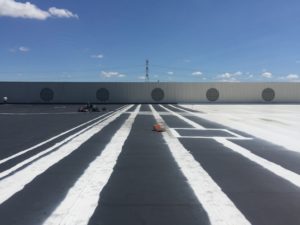ROOF REFLECTIVITY GREATLY IMPACTS INTERIOR TEMPERATURE
A major aspect to consider before you choose your next roofing system is reflectivity. Does the system you’re considering reflect UV rays or absorb them? This attribute will play a major part in the interior temperature of your building. Let’s look a little more closely at roof reflectivity and how it impacts you.
What Impacts Roof Reflectivity?
First off, what makes a roofing system more or less reflective? Why do some systems reflect over 90% of UV rays, while other systems absorb over 90%? The simplest and (as is often true) most accurate answer is the color of the roof. A darker roof will absorb more UV rays, while a lighter roof will reflect more. Other factors such as roof material chemistry and sheen can impact reflectivity, but color is the number one factor. So if you’re seeking a reflective roof, get one that is white or very close to it.

Why Does Reflectivity Matter?
The more UV rays your roof absorbs, the hotter the inside of your building will be. Experiments have shown buildings to be 60 degrees hotter on a 90 degree day when they have a dark roof compared to a light one. This matters because it keeps your building cooler and more comfortable, while (perhaps more importantly) saving you money on your cooling bills. A reflective roof can reduce cooling costs up to .$50 per square foot, so reflectivity matters quite a bit.
Which Roofs are the Most Reflective?
As described in the previous paragraph, roofs that are lighter are more reflective while roofs that are darker are less reflective (generally). A metal roof is typically middle of the road when it comes to reflectivity. It is usually a shade of gray, and therefore reflects in the ballpark of 50% of UV rays. Single-Ply roofing systems are mostly white and therefore offer great reflectivity. The one exception would be EPDM roofs that are black, rather than white. Built-up roofs typically have a tar and gravel top layer, making them very dark and therefore very absorbent of UV rays. When considering a new roof and considering reflectivity, just remember the rule of thumb that the lighter the roof, the more reflective.
The Winter Penalty?
Many building owners make the objection that a reflective roof will hurt them in the winter because they want the sun to heat their building when it gets cold. This is a valid argument, but the “winter penalty” isn’t as severe as many people think. In the summer, UV rays are aimed directly at your building. The sun takes a higher arc in the sky and therefore the rays become more direct. This means they heat your building more in the summer than in the winter, when the sun is lower and the rays are less direct. So, while the sun can heat your building’s interior up to 20 degrees in the summer, it can only do so 4-5 degrees in the winter.
Another objection related to this is raised by facility managers in snow-prone regions. They say “Don’t we want a dark roof to melt the snow?” This sounds logical at first, but once you consider that the snow covers the dark roof and the snow is white itself, you realize that the snow will cancel out any effects of the dark roof. If there is more than about an inch of snow, the color of your roof no longer matters.
Conclusion
Seeking a reflective roof for your building is a smart choice that can pay off financially. If you don’t completely need a new roof, but have a dark roof that you’d like to replace, contact us about a silicone roof coating to get a white surface on top. Our coatings reflect over 90% of UV rays and can greatly reduce your cooling costs.